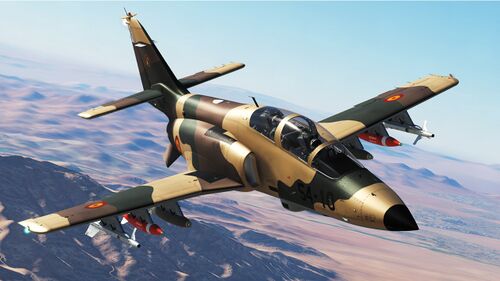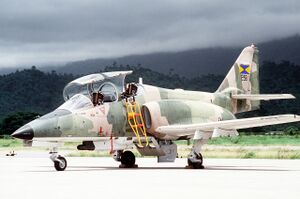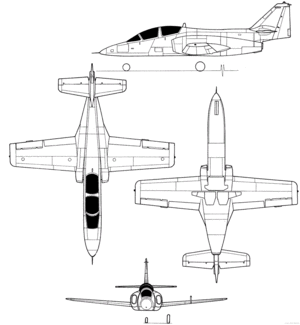ARCSA AL-80 Águila
This article is incomplete because it is pending further input from participants, or it is a work-in-progress by one author. Please comment on this article's talk page to share your input, comments and questions. Note: To contribute to this article, you may need to seek help from the author(s) of this page. |
| Aviones Reales Consolidados SA AL-80 Águila | |
|---|---|

. | |
| Artist rendering of the ARCSA AL-80 in attack configuration during development | |
| Role | Advanced trainer Light attack |
| National origin | |
| Manufacturer | Aviones Reales Consolidados SA (ARCSA) |
| First flight | March 1, 1988 |
| Introduction | July 11, 1991 |
| Status | In service |
| Primary user | Royal Mejian Army Air Corps |
The Royal Consolidated Aircraft SA AL-80 Águila is a is a low-wing single engine jet-powered advanced trainer and light attack aircraft designed and manufactured by Costa Mejian aircraft company Aviones Reales Consolidados SA. It was developed in the closing years of the Omandan Continental War following the removal of Soviet Order forces from Costa Mejis. Introduced in 1991, the aircraft saw limited service with the Royal Mejian Army Air Corps in the closing days of the war. Modernly, it continues to serve the Royal Mejian Army Air Corps as both an advanced trainer aircraft, as well as providing close air support to Mejian ground forces, as well as forces stationed in Costa Mejis by the Patrian Legion, both of whom are involved in ongoing counterinsurgency operations both within northern Costa Mejis as well as neighboring nations.
Design and development
Following the removal of Soviet Order forces from Costa Mejis in the early 1980s, the government of Costa Mejis faced the monumental task of rearming its nation's military. The majority of the Royal Mejian Army Air Crops aircraft had been destroyed during the initial Soviet invasion, destroyed by the occupying Soviet forces, or pressed into Soviet service and removed from the nation. As such, the Royal Mejian Army Air Corps was required to rebuild its aircraft inventory from scratch. Though this was initially accomplished by acquiring foreign aircraft from its allies, the Mejian government demanded that it begin producing its own arms domestically as soon as possible.
In regard to rearming its air forces, the government of Costa Mejis was keenly interested in multirole combat aircraft, which could serve in a variety of roles, including acting as both a fighter and attack aircraft, as well as advanced training and reconnaissance platforms. Ultimately, the Royal Army Air Corps would lobby sucsessfully that a dedicated fighter aircraft would be preferable to a single multirole platform, the requirements set forth by the Office of National Defense called for an aircraft able to act as an advanced pilot trainer, that also had attack and reconnaissance capabilities. In October 1984, ARCSA was awarded a development contract based upon their submission, requiring a pair of static airframes and four flight-capable prototypes to be built for testing purposes. To develop the aircraft, ARCSA sought technical assistance from several allied nations, including both Luminerra and Notreceau. Lumenic manufacturing conglomerate Altomare Aviation and Notreceauen defense company Prévoyance opted to participate in the venture; specifically, engineers at Altomare worked on the design of the rear fuselage and tail section while Prévoyance's team were responsible for the design of the aircraft's wings and engine inlets. Out of these efforts, a relatively conventional design was developed; and the principles of simplicity and economy were highly emphasized by the design, shunning high performance features in favor of cost effective solutions. However, one uniue feature included in the aircraft, primarily as a requirement for the aircraft's multi-mission role, is a large internal weapons bay located beneath the rear cockpit, which allowed for a wider variety of armament to be carried than the underwing hard points could accommodate; alternatively, this bay enabled the carriage of other equipment, including reconnaissance payloads.
In general design, the AL-80 is a low-mounted monoplane utilizing an unswept wing configuration. The cockpit, which is generally considered to be spacious when compared to aircraft of similar configuration and design, accommodates a crew of two in a typical tandem seating arrangement; however, the seats were staggered to provide the instructor in the rear position with greater visibility. The fuselage provided considerable internal space, permitting the installation of various additional aviation or supplemental systems to allow the aircraft maximum effiency in preforming secondary mission roles, including the ground attack capability specified in the original directive from the Office of National Defense, as well as armed escort, photographic reconnaissance, and as an electronic countermeasures platform.
Operational history
Variants
- AL-80: Initial production version utilized as an advanced trainer aircraft
- AL-80A: Upgrades performed in the mid-2000s enhancing the aircraft electronics and weapons systems
Operators
 Costa Mejis
Costa Mejis
 Shenandoah
Shenandoah
- Shenandoahan Air National Guard - The Shenandoahan Air National Guard operates a total of 12 aircraft designated as the A-3 Havoc. These aircraft are assigned to the 103rd Tactical Strike Squadron stationed at Ross Byrddie Air National Guard Base in Kanawha
Specifications
General characteristics
- Crew: 2
- Length: 12.5 m (41 ft 0 in)
- Wingspan: 10.6 m (34 ft 9 in)
- Height: 4.25 m (13 ft 11 in)
- Wing area: 20 m2 (220 sq ft)
- Aspect ratio: 5.6
- Powerplant: 1 × Obras de Motor Real OMR MTR-21541 turbofan engine, 19.13 kN (4,300 lbf) thrust
Performance
- Maximum speed: 769 km/h (478 mph; 415 kn) at 4,500 kg (9,921 lb) at sea level
- Cruise speed: 656 km/h (408 mph; 354 kn) / M0.6 at 9,145 m (30,003 ft)
- Stall speed: 183 km/h (114 mph; 99 kn)
- Never exceed speed: 834 km/h (518 mph; 450 kn) / M0.8 at 4,500 kg (9,921 lb)
- Combat range: 519 km (322 mi; 280 nmi)
- Ferry range: 2,000 km (1,243 mi; 1,080 nmi) with 30 minutes reserve
- Endurance: typical armed patrol – 3 hours 30 minutes
- Service ceiling: 12,800 m (42,000 ft)
- Rate of climb: 24.9 m/s (4,900 ft/min)
- Thrust/weight: 0.322
- Take-off run: 560 m (1,837 ft)
- Landing run from 15 m (49 ft): 800 m (2,625 ft)
Armament
- Guns: 1 x GIST 30 30 mm autocannon
- Missiles: 1x pylons located on the outboard portion of each wing for various types of IR-guided air-to-air missiles including the AIM-95, MD.2113 Mystique or MD.2115/MD.2213 Rouchet
- Bombs: Up to 2,220 kg (4,894 lb) disposable stores on 6 underwing pylons and one internal bay able to carry a variety of air to ground missiles, guided and unguided freefall bombs

